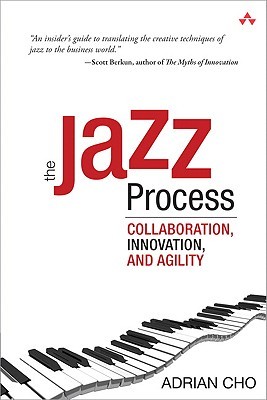The Jazz Process Summary
5 min read ⌚
 Collaboration, Innovation, and Agility
Collaboration, Innovation, and Agility
Business is like music. Teamwork is like playing in a band.
Read our summary of “The Jazz Process” and learn how to create a perfect balance between your creativity, and teamwork. Doing this will lead you to understand the business better, and succeeding in the market.
Who Should Read “The Jazz Process”? and Why?
Do you want to learn how jazz can change your business life?
Adrian Cho uses jazz and jazz bands to come up with 14 principles that will help you stand out in the market, and maintain your business. We recommend “The Jazz Process” to managers, executives, and employees who need to play new music that they would like their companies to dance on.
About Adrian Cho
 Adrian Cho is a software development manager for IBM and a jazz bassist who directs the Ottawa Jazz Orchestra of Canada.
Adrian Cho is a software development manager for IBM and a jazz bassist who directs the Ottawa Jazz Orchestra of Canada.
“The Jazz Process Summary”
Collaboration builds the society.
Ever since the beginning of civilization, humans connected and worked together. However, just adding more people to a project is not always equal to higher effectiveness and productivity.
The real goal in every process is the creation of synergy between group members. The chances of synergy happening are bigger for groups that are not too big. Think of a five-member basketball team or a jazz trio.
The thing that they have together is a small number of members, all of them contributing at their peak.
“The Jazz Process” pushes you to think of your work as a collaborative artistic performance, and makes you study the example of jazz.
Jazz musicians create their product on the fly, and they do so by minimizing rules, maximizing individuality, and carefully listening to each other’s ideas and opinions.
The skill set that underlines their creative geniuses consists of improvisation and innovation. They have to be ready to compose on the spot and react timely to unexpected changes in the rhythm.
What can you learn from this?
Well, like in creating music, improvisation is also necessary for the business world. In fact, improvisation and flexibility when circumstances on the market change are crucial for survival.
However, by improvisation, you will not be able to achieve that much if you do not have the right team that will demonstrate the collaborative agility that a jazz combo has.
Software code developers have a set of rigid standards they follow, to increase stability. On the other hand, a jazz trio uses and follows looser principles that exist to encourage instability.
Successful team building is only possible when clear standards exist, as well as a cooperative mindset that works within appropriate rules.
“The Jazz Process” will make you realize that instead of upholding a statutory code, provide axioms that exemplify a method for getting things done.
Such are the 14 standards of the “Jazz Process” which we will cover below.
Before you continue reading, we have to note that each of these standards has an upside and downside. Ultimately, the process is all about providing the environment for collaboration and constant learning. If you decide to use this method, keep in mind that to benefit from it, you should stay aware of the opportunities you reach out to, as well as being honest about what you need to correct.
Key Lessons from “The Jazz Process”
- Use Just Enough Rules
- Employ Top Talent
- Put the Team First
- Build Trust and Respect
- Commit With Passion
- Listen to Change
- Lead on Demand
- Act Transparently
- Make Contributions Count
- Reduce Friction
- Maintain Momentum
- Stay Healthy
- Exchange Ideas
- Take Measured Risk
Use Just Enough Rules
Make sure that you use rules that are not entirely limiting and that you keep autonomy during continual change and improvement.
Employ Top Talent
Keep in mind that the quality of your employees is the main ingredient in the mix of your success.
Put the Team First
Take after the jazz artists, and take care of errors together, just as you celebrate achievements as a unit. However, be careful not to enter into groupthink, and keep the diverse opinions and ideas inside the group. Be a team, but retain your individuality at the same time.
Build Trust and Respect
Trust and respect are the basis for creating a healthy bond within a team. When you nurture trust and respect, you will be able to build a productive working environment in which motivation and loyalty will be your most significant support.
Commit With Passion
Each team needs committed members for it to be stable. Low commitment means terrible results. Also, do not forget about passion. People need passion since it fuels them to overcome stressful situations and be remarkable no matter the circumstances.
Listen to Change
Implementation starts with listening. Research and collect as much data as you can before making a decision. In the process, you have to distinguish noise from actual information.
Lead on Demand
Learn to engage in a blend of leading and following, changing between the two in a moment’s notice, just like jazz players.
Act Transparently
Be transparent so that others can understand your decisions and actions. Credibility requires identity, trustworthiness, believability, and capability. Openness and clarity are essential within a team or organizations, while when it comes to competitors, keeping them in the dark should be part of your strategy.
Make Contributions Count
Not all contributions are valuable. If you contribute, make sure it is a positive and useful input. To do so, be resourceful and innovative. Also, remember that timing is everything. Solutions in ideas are only worth if you give them at a proper time.
Reduce Friction
Some friction is healthy, but other makes transactions challenging to execute. Hence, balance the amount of resistance in your business processes.
Maintain momentum
When things go well, your company has a momentum which is constructive and which you need to try to maintain. To keep the momentum going, focus on predictability and tend to the four aspects of the business: form, tempo, pulse, and groove.
Stay Healthy
Enterprises can suffer after a period of instability. Some of their problems will resolve themselves on their own, while others require outside help.
Exchange Ideas
To be successful in innovating, you have to involve yourself in two ways of thinking: divergent and convergent. Brainstorm in a group, exchange ideas and evaluate them properly.
Take Measured Risk
Managing risk is essential for survival; assess the risks you take, and act accordingly.
Like this summary? We’d Like to invite you to download our free 12 min app, for more amazing summaries and audiobooks.
“The Jazz Process” Quotes
Jazz can serve as an inspiration and example for anyone seeking to improve the skills of leadership, teamwork, innovation, and communication. Share on X The notion of team first is clearly important in a jazz ensemble. You simply cannot make music, let alone create amazing, unique music on the fly, if you’re dealing with a clash of titans or a failure to connect. Share on X When a team is trying to create something novel or unique, as jazz musicians often are, creative, individual statements are most needed. Share on X The concept of leadership has become way too complicated. Quite simply, one specific point defines leadership more than anything else: taking initiative. Share on X The most important point is not to kill people’s passion by failing them. Share on XOur Critical Review
“The Jazz Process” gives an interesting business analogy, and an in-depth look at teamwork and individuality, providing a large number of real-life examples.
Emir is the Head of Marketing at 12min. In his spare time, he loves to meditate and play soccer.


 Collaboration, Innovation, and Agility
Collaboration, Innovation, and Agility




